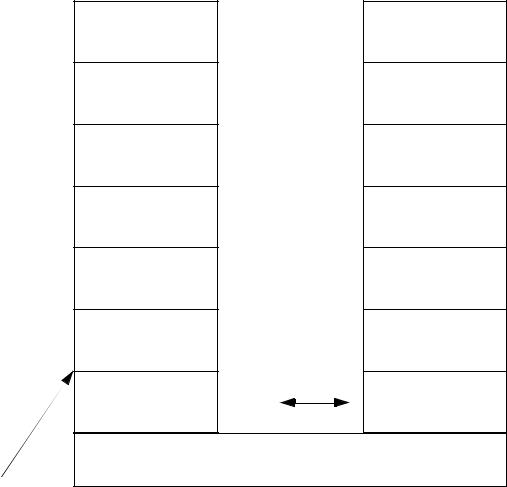
- •1. TABLE OF CONTENTS
- •2. COMPUTER HARDWARE
- •3. A BRIEF OVERVIEW OF COMPUTER HARDWARE
- •3.1 BASIC COMPONENTS
- •3.1.1 The components of a computer are,
- •3.1.2 Some I/O Devices
- •3.2 AN EXAMPLE OF A COMPUTER IN MANUFACTURING
- •3.3 COMMERCIAL COMPUTERS
- •3.3.1 Mainframes
- •3.3.2 Super Computers
- •3.3.3 Workstations
- •3.3.4 Personal Computers
- •3.3.5 Dedicated Computers
- •3.3.6 Single Board Computers
- •3.4 ARCHITECTURE AND BUSES
- •3.4.1 Clock Speed and the Buses
- •3.5 SOFTWARE
- •4. COMPUTER INTERFACING
- •4.1 DIGITAL SIGNALS
- •4.2 ANALOG SIGNALS
- •4.2.1 Analog to Digital Conversion
- •4.2.1.1 - Flash A/D Converter
- •4.2.2 Digital to Analog Conversion
- •4.3 TIMING
- •4.3.1 Interrupts
- •4.3.2 Clocks and Timers
- •4.3.3 Watch Dog Timers
- •4.3.4 Polling
- •4.4 DISPLAYS
- •5. COMPUTER INTERFACE BOARDS
- •5.1 OVERVIEW
- •5.1.1 Types
- •5.2 REGISTER LEVEL PROGRAMMING
- •5.3 EXAMPLES
- •6. COMPUTER CONTROL OF PROCESSES
- •6.1 TEMPERTURE CONTROL
- •6.2 BATCH PROCESSING
- •6.3 COMPUTER PROCESS MONITORING
- •6.4 IMPLEMENTING A COMPUTER CONTROL SYSTEM
- •6.4.1 SCADA
- •6.5 PRACTICE PROBLEMS
- •7. COMPUTER COMMUNICATIONS
- •7.1 COMPUTER COMMUNICATIONS CATEGORIES
- •7.2 THE HISTORY
- •7.3 SERIAL COMMUNICATIONS
- •7.6 GPIB/IEEE-488
- •7.7 PARALLEL COMMUNICATIONS
- •8. INTERFACING COMPUTERS FOR DATA TRANSFER
- •8.1 SERIAL DATA TRANSFER
- •8.2 PARALLEL DATA TRANSFER
- •8.2.1 GPIB Bus (IEEE-488)
- •9. COMPUTER NETWORKING
- •9.1 OSI NETWORK MODEL
- •9.1.1 Why Use A Network?
- •9.1.1.1 - Physical Layer
- •9.1.1.2 - Data Link Layer
- •9.1.1.3 - Network Layer
- •9.1.1.4 - Transport Layer
- •9.1.1.5 - Session Layer
- •9.1.1.6 - Presentation Layer
- •9.1.1.7 - Application Layer
- •9.2 OPEN SYSTEMS
- •9.3 NETWORKING HARDWARE
- •10. MANUFACTURING AUTOMATION PROTOCOL (MAP)
- •10.1 OVERVIEW
- •10.2 DETAILS
- •10.2.1 Physical Alternatives (Layer 1 OSI Model),
- •10.2.2 Data Link Layer (Layer 2 OSI Model),
- •10.2.3 Application Layer:
- •10.3 DETAILS FOR TOP
- •10.3.1 Application Layer:
- •10.5 MAP AND OTHER STANDARDS
- •10.6 AN EXAMPLE OF A MAP IMPLEMENTATION
- •10.7 ETHERNET
- •10.7.1 Internet
- •10.7.2 SLIP/PPP
- •10.8 DATA HIGHWAY+
- •10.9 REMOTE PLC I/O
- •10.10 DEVICENET
- •10.11 OTHER STUFF
- •10.12 Network Facts
- •11. DATABASE TECHNOLOGY
- •11.1 DISTRIBUTED DATABASE SYSTEMS
- •11.1.1 Relational database systems
- •11.1.2 Issues for distributed database systems
- •11.1.2.1 - Query processing
- •11.1.2.2 - Concurrency control
page 44
•Several types: Ring, Star, Linear, Point-to-Point
•Local Area Network (LAN), Wide Area Network (WAN)
9.1.1 Why Use A Network?
•Medium for Communication:
-Satellite link
-Phone line
-High Speed (Multiplexed) phone lines
-Coax Cable
-Fibre Optical Cable
-Twisted pair cable
-(Theoretically anything can be used)
•General OSI Diagram contains seven layers

page 45
Layer |
Layer Name |
Unit of Transmission |
|
7 |
Application |
Message |
Application |
6 |
Presentation |
Message |
Presentation |
5 |
Session |
Message |
Session |
4 |
Transport |
Message |
Transport |
3 |
Network |
Packet |
Network |
2 |
Data Link |
Frame |
Data Link |
|
|
Layer Protocol |
|
1 |
Physical |
Bit |
Physical |
Interconnecting Medium
A Layer Interface
9.1.1.1 - Physical Layer
•Physical layer is concerned with transmission of raw bits over a physical circuit.
•Deals with voltages, timing, connections, etc.
•Responsible for bit synchronization and the identification of a signal element as either a 0 or a 1.
•Protocols: RS-232, RS-449, CCITT X.25 and X.21, IEEE 802
page 46
9.1.1.2 - Data Link Layer
•Data link layer breaks input data into “data frames” and processes acknowledgments.
•Object is to provide a error-free transmission line to the network layer.
•Responsible for the reliable delivery of information over a point-to-point or multipoint link.
•Supervises interchange of both link control data and user information
•Protocols: ANSI X3.28, HDLC, X.25, ISDN, IEEE 802
9.1.1.3 - Network Layer
•Network layer determines the interface between the computer and the intermediate system, how packets are routed.
•Chooses a route from the available data links that form the network.
•Object is to take messages, convert them to packets and send them towards the destination.
•Protocols: CCITT X.25, X.21, IP, CCITT Q.931, ISO 8473
9.1.1.4 - Transport Layer
•Transport layer takes data from the session layer, splits it up if necessary, and passes this to the network layer.
•Ensures that pieces all arrive correctly at the other end.
•Isolates the user from any concern for the actual movement of the information.
•Protocols: TCP, ISO 8073
9.1.1.5 - Session Layer
• Session layer defines a connection between users (presentation layer processes).
page 47
•Includes specification of the remote machine, authorization, options for the communication, and recovering from errors in broken transport connections.
•The set-up of communications is called binding.
•Protocols: ISO 8327, CCITT X.225, T.62, ECMA 75, NFS, RPC.
9.1.1.6 - Presentation Layer
•Ensures compatible syntax among the communicating processes by adjusting data structures, formats, and codes.
•Presentation layer is generally represented by library routines which the user accesses to perform network operations.
•This layer can also perform transformations such as compression and encryption.
•Protocols: DIS 8823, 8824, 8825, CCITT X.409, T.61
9.1.1.7 - Application Layer
•Application layer is written by the user, or is a program that performs some function for the user.
•Provides a window by which the user gains access to the communication services provided by the architecture.
•Protocols: DIS 8571, 8832, 9040
